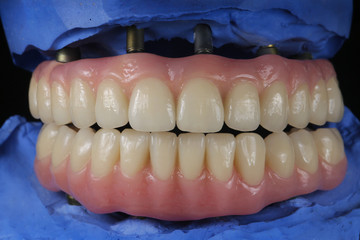Placing implants to replace all teeth is a comprehensive solution for those who have lost all their natural teeth. This method offers significant advantages over traditional dentures, ensuring optimal oral health and restoring the natural appearance and function of the mouth.
Implants provide exceptional stability, preventing denture movement and ensuring comfortable chewing and speaking. Patients do not need to worry about their teeth becoming loose or feeling unstable.
Implants act like natural tooth roots, stimulating the jawbone and preventing its recession. This maintains facial structure and prevents the facial aging caused by bone loss.
Implants offer a natural look and feel, fully restoring the aesthetics of the smile and the functionality of the mouth. Patients can chew and speak as they would with their natural teeth.
Unlike traditional dentures, which may require replacement or adjustments, implants provide a long-term solution with proper care and maintenance. This reduces the need for frequent dental visits for adjustments.
In the upper jaw, six implants are usually placed, upon which a fixed porcelain bridge is constructed. This bridge closely resembles the appearance and function of natural teeth, providing excellent aesthetics and functionality.
In the lower jaw, if the quality and quantity of the bone are sufficient, the same good result can be achieved with four implants. This offers the same stability and durability with fewer implants, reducing the time and cost of treatment.
The implantologist assesses the quality and quantity of the jawbone through CT scans and other diagnostic tools. If necessary, the implantologist may recommend bone regeneration before placing the implants. In collaboration with a specialist in aesthetic restorations, the exact placement of the implants is determined to ensure optimal aesthetics and functionality.
The implants are surgically placed into the jawbone by the implantologist. Placement is performed using a surgical guide according to the plan for maximum accuracy.
In some cases, a temporary denture or bridge may be placed during the healing period to maintain aesthetics and functionality.
The healing period allows the implants to integrate with the jawbone, a process that takes several weeks. During this time, the implantologist monitors the healing progress to ensure successful integration.
After the implants are fully integrated, the specialist in aesthetic restorations places the permanent porcelain bridge, providing a natural and functional result.
